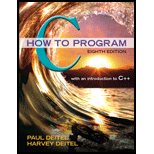
Concept explainers
(Enforcing Privacy with Cryptography) The explosive growth of Internet communications and data storage on Internet-connected computers has greatly increased privacy concerns. The field of cryptography is concerned with coding data to make it difficult (and hopefully—with the most advanced schemes—impossible) for unauthorized users to read. In this exercise you’ll investigate a simple scheme for encrypting and decrypting data. A company that wants to send data over the Internet has asked you to write a
Trending nowThis is a popular solution!

Chapter 3 Solutions
C How to Program (8th Edition)
- e) 11 players football team doing great in several tournaments. Unfortunately, one of the strikers got injured and replaced. He was a star player of the team. After his replacement, his team starts to perform badly. It looks like the whole team depending on one single player. Relate the above story with one of our cryptographic theories and provide an explanation.arrow_forwardComputer science In terms of encryption, what is the difference between file encryption and disc encryption?arrow_forwardFind the false statement: a. In modern Cryptography, symmetric key algorithms use same key both for Encryption and Decryption b. The symmetric cipher DES (Data Encryption Standard) was widely used in the industry for security product c. The AES (Advanced Encryption Standard ) cryptosystem allows variable key lengths of size 56 bits and 124 bits d. Pubiic key algorithms use two different keys for Encryption and Decryptionarrow_forward
- Name courses : data security Decrypt ciphertext obtained from aSubstitution Cipher. Note that there may be meaningless words at the beginning or at the end since the plaintext is divided into equalparts. NMDCUQFRWMYQWNMJUBDPGMSFMCUTWMJQYWLJWDRCZMDDGMJUFULSCQFPDSFYUTJQMTQYMJQMWRVSWFUNQCWPUFUUCWRLQRNTFWMJWRLDXPDSFYUMDAULWRTWMJMJUBDPGMSFMCUFUKCWUNQRNMJURMJUNWXXUFURMAFQRPJUYDXQFWMJBUMWPQBAWMWDRNWYMFQPMWDRSLCWXWPQMWDRQRNNUFWYWDRWRUIUFJUQFNDXSLCWXWPQMWDRQCWPUIURMSFUNMDYQZTJQMWYWMMJULFZKJDRCWXMUNSKADMJWMYKQTYWRYSFKFWYUTJQMRUIUFJUQFNDXSLCWXZWRLWMUHPCQWBUNZDSGRDTTJQMMDAUQSMWXZWYWYSKKDYUZUYYQWNQCWPUNDSAMXSCCZWMBUQRYMDBQGUQRZMJWRLKFUMMWUFTUCCMJURMJULFZKJDRTURMDRWXZDSNDRMGRDTTJQMMDSLCWXZWYZDSQFUQYWBKCUMRQCWPUNWNRDMXUUCURPDSFQLUNMDQYGQRZBDFUVSUYMWDRYQADSMWMYDJUMSFRUNMDMJUBDPGMSFMCUQRNYQWNTJQMUCYUJQNZDSMDCUQFRTUCCMJUFUTQYBZYMUFZMJUBDPGMSFMCUFUKCWUNPDSarrow_forwardtrue or false 11. One property of encryption algorithm is that someone can know the details of the algorithm and still not be able to decipher the encrypted message without knowing the key that the algorithm used to encrypt the message.arrow_forward7. Cryptography and Codes You are doing a Diffie-Hellman-Merkle key exchange with Autumn using generator 2 and prime 19. Your secret number is 2. Autumn sends you the value 4. Determine the shared secret key.arrow_forward
- It is important to distinguish between encoding and encryption.arrow_forwardCryptography problem mathematics Suppose Alice and Bob are using a cryptosystem with a 128-bit key, so there are 2128possible keys. Eve is trying a brute-force attack on the system.(a) Suppose it takes 1 day for Eve to try 264 possible keys. At this rate, how long willit take for Eve to try all 2128 keys? (b) Suppose Alice waits 10 years and then buys a computer that is 100 times fasterthan the one she now owns. Will she finish trying all 2128 keys before or after whatshe does in part (a)?arrow_forwardData Encryption Standard Perform a Data Encryption Standard encryption on the plaintext (PL) by using key (K). The PL is your first 8 characters of your name and K is the last 8 digits of your student ID. For example: Name: Siti Fajar Plain text (PL): SITIFAJA Student ID: 201908040016 Key (K): 08040016 Show detail step by step involved.arrow_forward
- In cryptography, the process of encrypting data is called the "salt" operation. You'll need to describe how it's put to use to make passcodes harder to crack.arrow_forwardCryptography is the study of protecting information. A cipher is a pair of algorithms ―the first algorithm encrypts a message and the second algorithm decrypts the message. In most cases, a unique key is also required to encode or decode plaintext. The Caesar cipher is one of the simplest and most widely known ciphers. It is named after Julius Caesar who allegedly used it to protect important military directives. Every letter in the plaintext is replaced by a letter N positions down the alphabet. For example, if N = 3, then a => d and b => e. While the idea is remarkably simple, it appeared to work in Ancient Rome. Most people there couldn't read, and those who could simply assumed it was a foreign language. Write a program that implements the Caesar cipher. You program will get from standard input the key N, followed by a line of plaintext. . . The key N should be any integer between 0 and 26 inclusive. If this isn't the case, print an error message and quit. Any numbers or…arrow_forwardPublic key cryptosystems are: (more than one may be true, choose all that are true) a offering a simpler way for key distribution B faster than symmetric C the preferred solution when the message we want to encrypt is very large D easily used to offer integrity E requiring advanced hardware in order to use them F easily used to offer confidentiality G marketed better than symmetric that is why people prefer them H using one key for encryption and a different key for decryptionarrow_forward
 Enhanced Discovering Computers 2017 (Shelly Cashm...Computer ScienceISBN:9781305657458Author:Misty E. Vermaat, Susan L. Sebok, Steven M. Freund, Mark Frydenberg, Jennifer T. CampbellPublisher:Cengage Learning
Enhanced Discovering Computers 2017 (Shelly Cashm...Computer ScienceISBN:9781305657458Author:Misty E. Vermaat, Susan L. Sebok, Steven M. Freund, Mark Frydenberg, Jennifer T. CampbellPublisher:Cengage Learning
